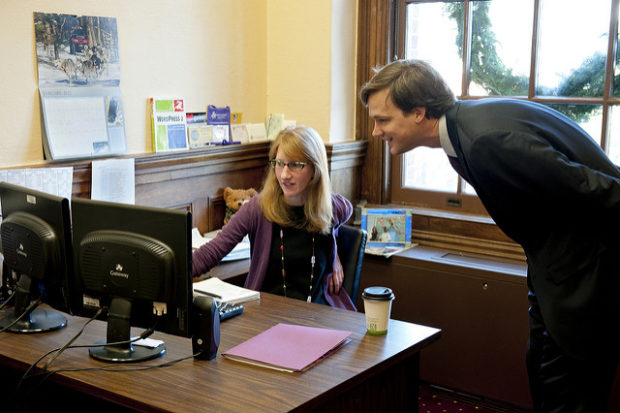From the Inside Out: The Unstoppable Power of Sustainable Teams

The concept of sustainability has long been at the forefront of public discourse surrounding climate change, becoming a top priority of business leaders and citizens alike. While much of the discourse about sustainability has centered around preserving and protecting the planet’s resources, the COVID pandemic has made it clear that sustainable business practices are just the beginning: a sustainable future must be one that also involves sustainable workplace cultures.
As the great resignation has made clear, employees’ expectations of their workplaces have shifted as a result of the pandemic. COVID-19 has brought longstanding inequities to the fore while causing serious detriments to workers’ physical and mental health. Just as the climate crisis has caused many of us to reflect on what it means to adopt a sustainable lifestyle, the COVID crisis has opened up a space for questioning what it means to lead truly healthy and sustainable working lives.
Fortunately, the widespread shift from in-person to remote work has opened up new and exciting ways of thinking about the future of work. Almost unthinkable before the pandemic, the adoption of a more flexible, employee-centric approach has made increased worker autonomy and more sustainable work-life relationships immediate possibilities for businesses in all sectors of the economy.
Creating a Work-Life Rhythm
For many of us, the pandemic has caused a profound shift in how we think about time. The rapid adjustment to new patterns of working and living has given many of us the opportunity to step back from pre-pandemic routines and think deeply about how we really wish to spend our time. Helping workers maximize their time both within and beyond the workplace will be a crucial goal for businesses hoping to lead the transition to a post-pandemic economy.
The language of sustainability provides us with a powerful metaphor for thinking about time: that is, as a non-renewable resource. Like any non-renewable resource, it must be treated with the utmost care and forethought.
Remote and Hybrid Work
The more flexible working hours made possible through remote or hybrid work are an exciting prospect to many employees, as they create the conditions for a much more personalized working life, one that is in harmony with one’s broader aspirations within and beyond the workplace. In order to deliver on some of the promises of this arrangement—which is not without potential pitfalls—we would do well to think about how best to make it sustainable.
As climate activists well know, sustainability requires us to make decisions for the present with the future in mind. For employees, this means considering how their work fits into the broader pattern of their lives. It means developing a self-improvement practice that helps consolidate skills learned on the job or even explore new ones. It means becoming an engaged member of a work environment that recognizes shared values. And it means taking advantage of flexible hours to be able to spend more time with family.
Employers play a crucial role in making this kind of arrangement possible. A Gallup study found that 70% of the variance in team engagement is determined solely by managers, and that more engaged teams created healthier, safer, and more productive work spaces. The same study identified some of the key drivers of employee engagement as a strong sense of purpose, experiences of personal development, and the opportunity for ongoing conversations with managers and other staff. By making time to ensure that their employees feel heard, employers can create a workplace climate that promotes individual growth in the interests of the company as a whole.

The Power of Boundaries
The establishment and ongoing enactment of proper work life boundaries creates the foundation from which a proper rhythm can be both modeled and maintained. Every vision of a work-life rhythm requires the successful mental toggling between work hours and at-home relaxation. Teams who are better able to take their rest will likewise be in a better position to feel engaged and mentally renewed when the time comes again to focus. But turning off the at-work mind requires practice in addition to intention.
Employers and team leads can be the first to step up to the plate. As a whole, the team can determine the kinds of boundaries that are most conducive to their long-term success. Setting strict notification hours, encouraging and/or enforcing paid days off, and having wellness practices integrated into a weekly schedule are often popular choices. It’s then up to the managerial teams to set the example in respecting and upholding those boundaries. If an employer intends to have the whole team offline by 6pm, but responds to an email around 7:30pm, they’re setting an unconscious standard that other team members might do the same. Boundaries are best with full buy-in; sustainable teams are constantly considering the boundaries they have in place and the ways in which they’re being enacted in their day-to-day.
Autonomous Offerings—The Best Path Forward
Flexibility is a word we’ve seen resurface as the workforce at large seeks its balance between a return to in-office operations and a continuation of fully remote work. But the concept itself can be vague. In an important and recent report, the Harvard Business Review advocated instead for an emphasis on ‘autonomy’ over flexibility.
Included in their findings is the insight that while people certainly seem to have preferences regarding where and how they work, the most important thing for employees is that they themselves have the freedom and agency to voice those preferences and prioritize them in their working arrangements. 61% of respondents wanted more than anything the choice to determine from where they’d be working on a daily or weekly basis; to have the option to come into the office if they needed, or to work from home if that would help them better perform their tasks for the day.
The value of autonomy
Likewise, autonomy across team boundaries, autonomy over personal schedules, and some sense of financial autonomy are playing leading roles in our collective return to Workplace 2.0. Financial autonomy is coming in part by the recognition among employers that a look at what makes a competitive wage is needed for this recovery stage. More frequent payments and more robust benefits will help individual employees remain in charge of their financial and physical health; two elements that absolutely preclude a sense of wellbeing at work.
In short, opportunity abounds to get closer to a ‘normal’ in which business is used as a vehicle of fulfillment, community, purpose and profit; a way of working that’s sustainable, motivating, and meaningful over the long-term outlook of individual lives. After two years of a perspectival adjustment brought on by the COVID-19 crisis, leaders are finding success in encouraging a work-life rhythm, modeling the upholding of boundaries that makes that possible, and offering true employee autonomy in all its myriad forms. The reward will be a workforce that finds a renewable sense of meaning, purpose, and energy in their work; an end destination that’s well worth striving for.
This guest post was authored by Tara Milburn
Tara Milburn is the CEO of Ethical Swag, a sustainable branding company that helps HR professionals and business leaders meet their ESG goals. A certified B-Corporation, Ethical Swag has been audited to the highest standards of sustainability and helps business owners achieve their ESG goals from the culture they establish to the products they use.

